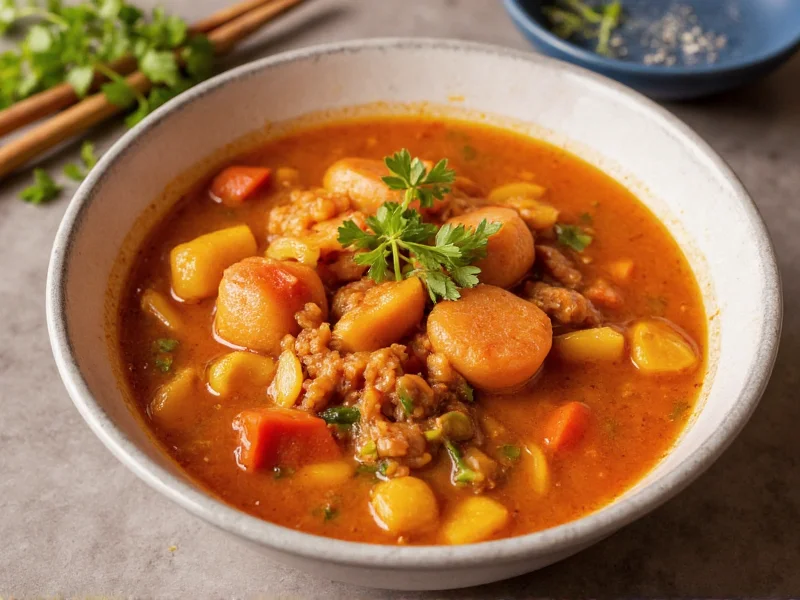Sweet and sour soup represents one of China's most celebrated culinary traditions, with roots tracing back to the Fujian and Jiangsu provinces. This beloved dish showcases the Chinese culinary philosophy of balancing opposing flavors to create harmony. Unlike the heavily sweetened American-Chinese restaurant versions, authentic sweet and sour soup achieves equilibrium between tangy and sweet notes without overwhelming either component.
The Historical Journey of Sweet and Sour Soup
Originating in eastern China centuries ago, sweet and sour soup evolved as chefs experimented with preserving techniques that required vinegar for food safety, later incorporating sugar to balance the sharp acidity. The dish gained prominence during the Ming Dynasty (1368-1644) when culinary arts flourished. Traditional Chinese medicine principles influenced its development, as the combination of sour (associated with liver health) and sweet (beneficial for spleen function) created a dish believed to promote digestive balance.
Authentic Ingredients vs. Common Substitutions
True sweet and sour soup relies on specific ingredients that create its distinctive profile. The foundation consists of:
| Traditional Ingredient | Purpose | Common Substitutions |
|---|---|---|
| Chinkiang vinegar | Provides deep, complex sourness | Rice vinegar, apple cider vinegar |
| Rock sugar | Creates clean sweetness that dissolves evenly | White sugar, honey |
| Shaoxing wine | Adds depth and removes fishy flavors | Dry sherry, omit entirely |
| Wood ear mushrooms | Provides texture contrast | Button mushrooms, omitted |
Regional Variations Across China
China's regional cuisines have developed distinct interpretations of sweet and sour soup:
- Fujian style: Features delicate broth with bamboo shoots, mushrooms, and thinly sliced pork, emphasizing subtle sweetness from natural ingredients
- Cantonese version: Incorporates seafood like shrimp or fish, with a slightly thicker consistency and more pronounced sour element
- Sichuan adaptation: Adds subtle heat with pickled chili peppers while maintaining the sweet-sour balance
- Northern Chinese interpretation: Often includes more vegetables and sometimes tomato for additional complexity
Creating Authentic Sweet and Sour Soup at Home
Preparing traditional sweet and sour soup requires attention to technique rather than exotic ingredients. The key lies in the proper sequencing of adding sour and sweet components. Begin with a clear chicken or vegetable broth as your base, bringing it to a gentle simmer. Add your protein (typically pork, chicken, or shrimp) first, followed by vegetables like bamboo shoots, wood ear mushrooms, and bell peppers.
The critical moment comes when balancing the signature flavors. Add vinegar first to allow its sharpness to mellow slightly in the hot broth, then gradually incorporate sugar while tasting. The ideal ratio varies by regional preference but generally falls between 2:1 and 3:1 (broth to vinegar) with sugar adjusted to personal taste. For proper texture, create a slurry of cornstarch and cold water, then slowly whisk it into the simmering soup until it reaches a delicate sheen.
Avoiding Common Preparation Mistakes
Many home cooks encounter issues when preparing sweet and sour soup. The most frequent errors include:
- Adding sugar and vinegar simultaneously, preventing proper flavor integration
- Using artificial red coloring instead of achieving natural color from ingredients
- Over-thickening the soup, resulting in a gloppy rather than silky consistency
- Boiling the soup after adding the cornstarch slurry, causing breakdown of the thickening agent
- Using ketchup as the primary sour component, which creates an unbalanced flavor profile
Nutritional Profile and Dietary Adaptations
Sweet and sour soup offers a relatively balanced nutritional profile when prepared traditionally. A standard serving (1 cup) typically contains 80-120 calories, with minimal fat and moderate protein depending on the meat or seafood used. The vegetable content provides vitamins A and C, while the broth base contributes hydration and electrolytes.
For dietary adaptations:
- Vegetarian version: Substitute mushroom broth for meat-based stocks and use tofu or extra vegetables
- Low-sodium option: Use homemade broth and reduce added salt while increasing ginger for flavor
- Gluten-free preparation: Ensure cornstarch is pure and verify broth ingredients
- Vegan adaptation: Combine vegetable broth with tofu and additional mushrooms for umami
Serving Traditions and Pairings
In Chinese culinary tradition, sweet and sour soup serves as a qi wei (appetizer soup) designed to prepare the palate for the meal. It's traditionally served before the main courses in small bowls. The ideal temperature is hot but not scalding, allowing the nuanced flavors to be appreciated.
Pair this soup with:
- Steamed jasmine rice as a light meal
- Complementary dishes like kung pao chicken or stir-fried greens
- A simple cucumber salad to continue the refreshing theme
- For a complete meal, follow with a protein-focused main course
Preserving Culinary Authenticity
As sweet and sour soup has gained global popularity, maintaining authenticity becomes increasingly important. True Chinese sweet and sour soup differs significantly from the American-Chinese restaurant version that often features bright red coloring and excessive sugar. The authentic preparation celebrates balance rather than dominance of either sweet or sour elements. When prepared correctly, the soup should refresh the palate rather than overwhelm it, embodying the Chinese culinary principle that food should both nourish the body and delight the senses.











 浙公网安备
33010002000092号
浙公网安备
33010002000092号 浙B2-20120091-4
浙B2-20120091-4